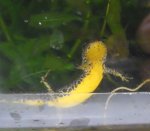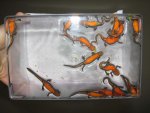froggy
Site Contributor
- Joined
- Nov 8, 2002
- Messages
- 1,779
- Reaction score
- 28
- Points
- 48
- Age
- 35
- Location
- Manchester, England
- Country
- United Kingdom
- Display Name
- Chris Michaels
I have recently reared a large number of larvae of this species through metamorphosis. The diet has been about 80-90% BBS, with the rest comprising bloodworm and Daphnia, but all the morphs have yellow bellies with no hint of orange - even at 2 months post metamorphosis (see attached photo). Post morphing, aquatic juveniles have had bloodworm, earthworm, hoglice and whiteworm, while terrestrial juvies have had earthworm, whiteworm, springtails and crickets gutloaded with carotenoids. None of the animals have developed orange bellies.
Any idea what has gone wrong here?
C
Any idea what has gone wrong here?
C



